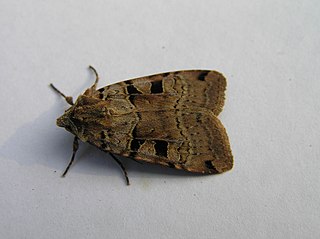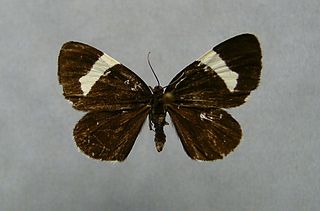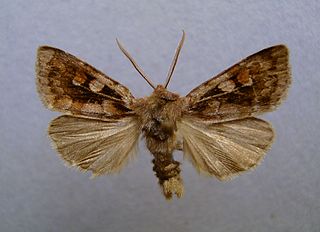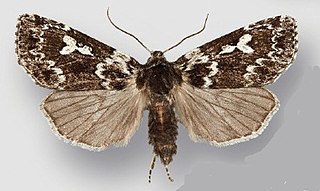
Nordstrom, Inc. is an American luxury department store chain. Founded in 1901 by John W. Nordstrom and Carl F. Wallin, it originated as a shoe store and evolved into a full-line retailer with departments for clothing, footwear, handbags, jewelry, accessories, cosmetics, and fragrances. Some stores feature home furnishings and wedding departments, and several have in-house cafes, restaurants, and espresso bars.

The setaceous Hebrew character is a moth of the family Noctuidae. The species was first described by Carl Linnaeus in his 1758 10th edition of Systema Naturae. It is found in the Palearctic realm. It is a common species throughout Europe and North Asia and Central Asia, South Asia, China, Japan and Korea. It is also found in North America, from coast to coast across Canada and the northern United States to western Alaska. It occurs in the Rocky Mountains from Montana to southern Arizona and New Mexico. In the east, it ranges from Maine to North Carolina. It has recently been recorded in Tennessee.

The double square-spot is a moth of the family Noctuidae. It is distributed through most of Europe except Portugal, the Mediterranean islands and northernmost Fennoscandia. In the East, the species ranges East across the Palearctic to Siberia and in the South-East to the Black Sea and in Iran. It rises to a height of about 2000 metres in the Alps.

The square-spot rustic is a moth of the family Noctuidae. It is found in Europe, North Africa and east across the Palearctic and in North America.

Xestia is a genus of noctuid moths. They are the type genus of the tribe Xestiini in subfamily Noctuinae, though some authors merge this tribe with the Noctuini. Species in this genus are commonly known as "clays", "darts" or "rustics", but such names are commonplace among Noctuidae. Xestia moths have a wide distribution, though they most prominently occur in the Holarctic.
Banksia borealis is a species of sprawling shrub that is endemic to Western Australia. It has leaves with sharply pointed lobes on each side, between thirty and fifty flowers in a gold-coloured spike and egg-shaped fruit. There are two subspecies occurring in two disjunct areas.

Xestia baja, the dotted clay, is a species of moth of the family Noctuidae. It is found in Europe, Turkey, northern Iran, Transcaucasia, the Caucasus, central Asia, Siberia, Mongolia, Tibet, China, Korea and Japan.

Baptria is a monotypic moth genus in the family Geometridae erected by Jacob Hübner in 1825. Its only species, Baptria tibiale, was first described by Eugenius Johann Christoph Esper in 1791. It is found in central and northern Europe.

Xestia alpicola, the northern dart, is a moth of the family Noctuidae. It is found from northern Europe across the Palearctic to central Siberia and in the Alps.

Xestia ditrapezium is a moth of the family Noctuidae found in most of Europe, northern Turkey, northern Iran, Transcaucasia, Caucasus, central Asia, from the Altai to Ussuri, Amur, Kuril Islands, northern Mongolia, Tibet, China, Korea, and Japan.

Xestia stigmatica, the square-spotted clay, is a moth of the family Noctuidae. It is found in most of Europe, Transcaucasia, Caucasus, Kazachstan, northern Turkey and northern Iran.

Xestia perquiritata, the boomerang dart, is a moth of the family Noctuidae. The species was first described by Herbert Knowles Morrison in 1874. It is found across North America from Newfoundland, Labrador and northern New England, west to central Yukon, British Columbia and Washington. There are several disjunct populations, including one in the Great Smoky Mountains National Park and the Rocky Mountains in Colorado and a coastal bog in central Oregon.

Xestia speciosa is a moth of the family Noctuidae. It is found in northern Europe, including Fennoscandia, the Baltic region, parts of Russia and further through northern Asia to the Pacific Ocean and Japan. It is also found in the mountainous areas of central and southern Europe. It is also present in north-western North America.

Xestia collina is a moth of the family Noctuidae. It is found in the Alps, from southern France to southern Poland, Romania, from southern Finland and Estonia to the Urals, Siberia and northern Mongolia.

Xestia trifida is a moth of the family Noctuidae. It is found in Romania, Ukraine, southern Russia, Turkey and Turkmenistan as well as the Iberian Peninsula.

Xestia ochreago is a moth of the family Noctuidae.

Xestia staudingeri is a moth of the family Noctuidae. It is known from Siberia, as well as North America.

Xestia tecta is a moth of the family Noctuidae. In Europe the species is only known from the boreal area of Fennoscandia, north-western Russia and the northern Ural Mountains. Outside Europe it occurs in northern and central Siberia and the north-western USA including Alaska as well as north-western and central Canada.
Xestia gelida is a species of moth belonging to the family Noctuidae.
Xestia distensa is a species of moth belonging to the family Noctuidae.
















